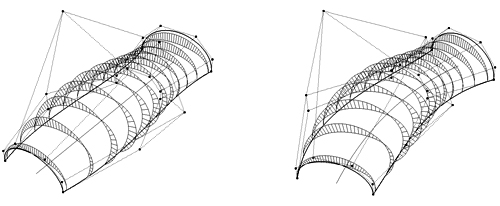|
Interactive Equilibrium Modeling |
L. Lachauer 2010 - 2015 |
In this dissertation, new approaches to the design of non-standard building
structures with efficient static behaviour are presented. Computer-aided
modelling tools enable architects to design spectacular buildings with complex
geometry; through strong numerical methods, civil engineers are able to
statically analyse and design corresponding structures. The often strong
separation between architectural and structural design processes largely results
in inefficient structural behaviour and high consumption of resources.
The aim is to develop a structural design methodology which combines
principles of static equilibrium with computer-aided design concepts. For this
purpose, an interactive modelling approach is described, enabling the designer
to iteratively bring together design idea and efficient structural behaviour. On
the one hand, the relevance of this dissertation lies in its contribution to
reducing the gap between free architectural design and scientific structural
design. On the other hand, the relevance lies in the systematisation and
facilitation of the design process for geometrically complex building structures
with efficient force flow.
The presented modelling approaches are built upon the conceptual
framework of truss models, combined with computational form-finding
methods. In a first step, tailored equilibrium modelling methods for selected
typologies of structures, e.g. curved bridges or branching columns, are
developed. Each of these modelling methods is based on well-defined structural
concepts. Through customised, case-specific adaptation of standard formfinding
techniques, the boundary conditions of the underlying structural
concepts are inscribed in these interactive modelling processes. In a second
step, a general equilibrium modelling approach is developed, which allows
generic boundary conditions to be defined to address different structural
concepts.
This general modelling approach is based on a new technique to solve formfinding
problems with constraints both on the form and on the inner forces.
For this purpose, the Force Density Method has been extended in a new way.
Previously, several approaches were formulated in order to add boundary
conditions to the Force Density Method, but these were largely driven by
specific construction and fabrication properties. Here, general constraints are
used to enable early-stage structural design explorations with a high degree of
geometric control.
The flexibility of the new method is demonstrated in nine prototypical case
studies. The first group of cases demonstrates that the method enables the
exploration of the inherent geometric freedom of renowned structural
typologies. The second group of cases demonstrates that the method is also
suited for creating new typologies, by combining and merging given structural
models.
The following contributions to the body of knowledge have been made:
tailored modelling approaches for selected structural typologies were developed; a general equilibrium modelling approach based on a new
extension
of the Force Density Method was formulated; case studies illustrating the
modelling process of selected structures were presented. Furthermore, the new
solving technique for form-finding problems with boundary conditions
establishes the conceptual basis for a new computer-aided structural design
tool.
Keywords:
structural design, computer-aided design, geometric modelling, architectural
geometry, equilibrium solutions, strut-and-tie models, constrained form
finding, Force Density Method

Parametric model of a roof with efficiently shaped trusses

Parametric model of a roof with efficiently shaped trusses
last modified 26.1.2016